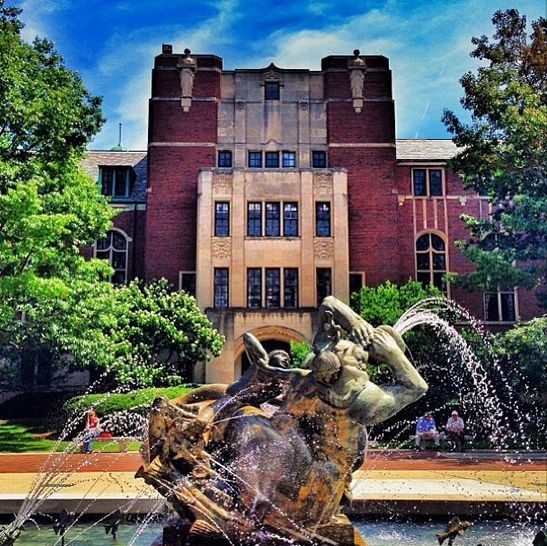Ingalls Mall and the Michigan League
Introduction
Text-to-speech Audio
“Friendship” and “character.” The cornerstone of the historically female Michigan League, laid in 1928, is said to represent these two traits, while the historically male-only Union—which was brought up earlier—has statues said to represent “athleticism” and “scholarship.” Though this difference in language may seem minute, it emphasizes a long history of female oppression at the university level.
Images
Ingall's Mall

Backstory and Context
Text-to-speech Audio
In the 1920s, women were not allowed to enter the Union unless they used a side door and were accompanied by a male, so a group known as the Women’s League convinced the Regents to raise $1 million for a community space for women’s activities. Though women were finally allowed to enter the Union in 1956, structural sexism persisted.
One issue that continued to plague female students was oppressive lifestyle mandates dictated by Deborah Bacon, the university’s Dean of Women. Bacon’s administration was infamous for its conservative views of female sexuality, and she enforced strict curfews, dress codes, and punished girls who were caught kissing in public spaces.
In 1952, male students rebelled against conservative PDA rules by storming into the female dorms on the Hill. They surged through stairwells, climbed up walls, and seized women’s lingerie as souvenirs while the women poured buckets of water on them from the windows. The women countered by attacking the Union, where they scandalously entered through the front door and stampeded into the all-male West Quad. The pandemonium finally ended when Bacon appeared, who intimidated the women into returning home before curfew. This eventful evening would come to be known as the nation’s first “Panty Raid.”
Bacon’s conservative opinion of sexuality was also racially motivated, as she did not believe that white women should date Black men. If she discovered a female student spending significant amounts of time with a Black man, she would call the female student’s parents. This conflict escalated into the women on campus demanding liberation by submitting testimonies of discrimination at the hands of Bacon to reporters at the Michigan Daily, who took this information to the Board of Regents. By 1961, Bacon recognized her conservative views no longer fit the social developments on campus and resigned.
Unfair treatment was not limited to students, as female faculty members faced their own share of struggles. The 1970s were critical for many issues: female faculty made up only 4.8 percent of all professors, and of this 4.8 percent nearly all were white women. For the small group of women who secured a professorship, one of the most glaring issues was the wage gap. In 1970—100 years after women were first admitted to the university—women with 10-20 years of work experience earned only 64 percent of men’s salaries.
Jean King, a lawyer who worked at the university, sought to remedy this. She filed a case using a Civil Rights-related executive order that prohibited federal contractors—such as universities—from discriminating on the basis of gender. Along with a network of friends and staffers, King copied and compiled sensitive university documents that supported her legal case, while a women’s rights group called FOCUS posted notices inside women’s bathrooms on campus to quietly gain support for the movement.
The university eventually caved under pressure from activists such as King and created a Commission for Women in the late 1970s. Women’s salaries that were more than 10 percent under the average male salary were subjected to immediate readjustment.
From salaries to sexuality to community spaces, women on our campus have fought—and continue to fight—fiercely for liberation.
Sources
Bordin, Ruth. Women at Michigan: The “Dangerous Experiment,” 1870s to the Present. Ann Arbor: University of Michigan Press, 1999.
Brookfield, Molly, Abigail Esbrook, Sophia Kaufman, Laura Marsh, Michelle McClellan, Mel Neal, Levi Teitel, Emma Stout. “A Dangerous Experiment”: Women at the University of Michigan” (online exhibit). Accessed October 20, 2022.
Holdship, Deborah. “Episode 41: The conquering heroines of Title IX, featuring Sara Fitzgerald, BA ’73.” Michigan Today, October 24, 2020.
Holdship, Deborah. “U-M acquires papers of alumnus and activist Tom Hayden.” University Record, September 2, 2014.
Schwert, Kia. “In Loco Parentis,” in Mental Health at Michigan (online exhibit).
Tobin, James. “Dean Bacon’s demise.” Michigan Today, October 22, 2014.
Ingalls Mall - Ann Arbor, MI: Ann Arbor Michigan, Michigan, Eastern Michigan University. Pinterest. (2017, September 5). Retrieved November 28, 2022, from https://www.pinterest.com/pin/847380486109370098/
